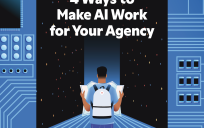The government is developing its first-ever Federal Data Strategy to serve as a foundation for how its workforce uses artificial intelligence (AI) and machine learning for managing vast amounts of information, according to Federal Chief Information Officer Suzette Kent.
“Technology modernization allows us the opportunity to rethink our foundation,” Kent said Wednesday at the “Evolving the Modern Enterprise with AI and Machine Learning” event in Washington, D.C. “We have to move aggressively. We don’t want to build the high-speed train without the track.”
Kent added that “big data is powerful, but it has to coexist with sound data management strategies as well.”
The President’s Management Agenda (PMA) released last March tasked the federal government with developing and implementing a comprehensive data strategy.
“The Federal Government needs a robust, integrated approach to using data to deliver on mission, serve customers, and steward resources while respecting privacy and confidentiality,” according to the PMA’s Cross-Agency Priority (CAP) Goal: Leveraging Data as a Strategic Asset. “Data provided by the Federal Government have a unique place in society and maintaining trust in Federal data is pivotal to a democratic process.”
The Federal Data Strategy’s development will be based on input from agencies, federal data communities and stakeholders and the public.
The initiative’s website says it will “define Principles, Practices and a Year 1 Action plan to deliver a more consistent approach to federal data stewardship, use, and access.”
“Over the course of the next year, with input from the full spectrum of government and non-government stakeholders, the first government-wide data strategy will be developed, along with plans for implementation,” it adds.
Kent said modernizing how federal employees use technology is essential to crafting the government’s data strategy.
“A critical part of the PMA is transforming the workforce of today into a workforce where almost every job has a technology element,” she said.
“We have to look at the tools we give our workforce and how we train our workforce to be successful in that space,” Kent added. “It’s not just reskilling but defining those skills we’ll need for the 21st century.”
Kent said completing the Federal Data Strategy would enable AI and machine learning implementation, freeing up government employees for other tasks.
“We have a mandate to automate many processes now through law,” she said. “We have a lot of automation tools that provide easy steps.”
“That’s what our citizens expect – instantaneous interaction and service,” Kent continued. “That’s not the future. Those are things we can do today.”
Kent added that building a Federal Data Strategy could transform how the government operates and delivers services.
“We’re thinking about data-sharing principles, the role of government [and] public collection of data,” she said. “We’re rethinking some of the things we do from a public-private perspective.”
“And we’re also looking at regulation,” Kent said. “Many of the things we do today were formed in a different era when the tools were different.”
Kent called the Federal Data Strategy “such an important part of our goal going forward” on AI and machine learning.
“We’re updating systems we haven’t touched in decades,” she said. “That’s what we’re talking about with IT modernization.”
“We have the opportunity to rationalize how we look at data,” Kent added. “Now is the time to actually build the foundation where we can actually leverage machine learning and AI.”





Leave a Reply
You must be logged in to post a comment.